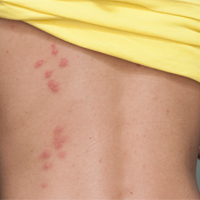Increasing Your Bed Bug Awareness
This information was reviewed and approved by Rosine Angbanzan, MPH (7/1/2019).
Bedbugs are increasingly infesting areas where people sleep and spend time in the United States. These areas may include homes, apartments, hotels, dorm rooms, hospitals, homeless shelters and schools. There may be a number of reasons for this. These include:
Increased national and international travel
Bedbug resistance to available pesticides
Decreased awareness of bedbug prevention and infestation.
What are bedbugs?
Bedbugs are a type of insect that feeds on blood. They bite humans to obtain blood for growth. Unlike some other biting bugs, bedbugs don’t transmit disease when they bite.
In one to two months, an egg can grow through several stages to become an adult bedbug. Bedbugs are active at night.
What do bed bugs look like?

It is important to know what bedbugs look like in the various stages of development. An adult bedbug can lay four to five eggs a day. The eggs are a clear to white color and about 1 mm long.
As bedbugs develop over one to two months, they become a darker color with darker stripes. An adult bedbug is oval to round shape and may be 1-7 mm in length.
How do bed bugs infest an environment?
Bedbugs can infest an environment when a bedbug is brought from an infested area into an environment that is not infested. Bedbug infestation can occur in any area where people sleep and spend time. Bedbug infestation is not related to cleanliness.
How can you tell if you have bed bugs?

Awareness of bed bugs is important.
- Know what bed bugs look like in various stages of development.
- Know where to look for bed bugs. In areas where people sleep or spend time, bedbugs may hide in the creases of a mattress, behind picture frames and bed frames and in cracks in the wall and floorboards.
- Know what remnants of bed bugs to look for. Bedbugs are active at night, so you may also see remnants of bedbugs during the day. There may be dark spots or droppings, skin sheddings of bedbugs, eggs and possibly drops of blood.
- Know what bed bug bites look like. Bedbug bites on the skin are also an indication that bedbugs may be present. Bedbug bites may look like raised welts. They often itch. People react differently to bedbug bites. Some people develop a small welt, while some develop a bigger welt. Several bites may occur in a row.

If these indications of bedbugs are identified, the environment may need to be inspected by a pest control professional familiar with bedbugs.
How can you prevent a bed bugs infestation?
When at home:
Be aware of what signs of bedbugs to watch for.
Check areas of the home after you have house guests.
Watch for signs of bedbugs when children return from college, camp or overnights.
Avoid purchasing or renting used furniture. If you do purchase or rent used furniture, check it closely before bringing it into your home.
Encase the mattress and box springs in dust proof mattress encasings.
Seal any cracks in the home.
When you travel:
Check for bedbugs when you stay at hotels.
Keep suitcases off the floor or bed. Inspect the suitcase before bringing it into your home.
If you suspect there may be bedbugs in your luggage, leave the suitcase outside. Place any clothes in a plastic bag or leave them outside until you can wash them in hot water.
What can you do if you have a bed bug infestation?
There are specific treatments that are helpful, but treatment can be difficult and often needs to be repeated. The earlier the infestation is identified, the easier the treatment becomes. Although cleanliness isn’t an indicator for bedbug infestations, treatment can be more difficult when rooms are more cluttered. Consulting a reputable pest control specialist who is familiar with bedbugs is important. Consider interviewing several companies before you select one.
Consult a health care professional if allergic reactions develop after bedbug infestations.
Don’t panic and discard belongings. Washing and treatment can get rid of bedbugs.
Remember, increasing your awareness of bedbugs can help you prevent, identify and treat an infestation early.
Additional resources:
